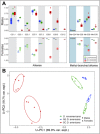A shift to shorter cuticular hydrocarbons accompanies sexual isolation among Drosophila americana group populations
- PMID: 34621538
- PMCID: PMC8484720
- DOI: 10.1002/evl3.246
A shift to shorter cuticular hydrocarbons accompanies sexual isolation among Drosophila americana group populations
Abstract
Because sensory signals often evolve rapidly, they could be instrumental in the emergence of reproductive isolation between species. However, pinpointing their specific contribution to isolating barriers, and the mechanisms underlying their divergence, remains challenging. Here, we demonstrate sexual isolation due to divergence in chemical signals between two populations of Drosophila americana (SC and NE) and one population of D. novamexicana, and dissect its underlying phenotypic and genetic mechanisms. Mating trials revealed strong sexual isolation between Drosophila novamexicana males and SC Drosophila americana females, as well as more moderate bi-directional isolation between D. americana populations. Mating behavior data indicate SC D. americana males have the highest courtship efficiency and, unlike males of the other populations, are accepted by females of all species. Quantification of cuticular hydrocarbon (CHC) profiles-chemosensory signals that are used for species recognition and mate finding in Drosophila-shows that the SC D. americana population differs from the other populations primarily on the basis of compound carbon chain-length. Moreover, manipulation of male CHC composition via heterospecific perfuming-specifically perfuming D. novamexicana males with SC D. americana males-abolishes their sexual isolation from these D. americana females. Of a set of candidates, a single gene-elongase CG17821-had patterns of gene expression consistent with a role in CHC differences between species. Sequence comparisons indicate D. novamexicana and our Nebraska (NE) D. americana population share a derived CG17821 truncation mutation that could also contribute to their shared "short" CHC phenotype. Together, these data suggest an evolutionary model for the origin and spread of this allele and its consequences for CHC divergence and sexual isolation in this group.
Keywords: cuticular hydrocarbons; drosophila; reproductive isolation.
© 2021 The Authors. Evolution Letters published by Wiley Periodicals LLC on behalf of Society for the Study of Evolution (SSE) and European Society for Evolutionary Biology (ESEB).
Conflict of interest statement
The authors have declared no conflict of interest.
Figures



References
-
- Bartelt, R. J., Armold M. T. , Schaner A. M., and Jackson L. L.. 1986. Comparative Analysis of Cuticular Hydrocarbons in the Drosophila Virilis Species Group. Comp. Biochem. Physiol. 83B:731–742.
-
- Basolo, A. L.1995. Phylogenetic evidence for the role of a pre‐existing bias in sexual selection. Proc. Biol. Sci. 259:307–311. - PubMed
-
- Baxter, C., Mentlik J., Shams I., and Dukas R.. 2018. Mating success in fruit flies: courtship interference versus female choice. Anim. Behav. 138:101–108.
-
- Billeter, J. C., Atallah J., Krupp J. J., Millar J. G., and Levine J. D.. 2009. Specialized cells tag sexual and species identity in Drosophila melanogaster. Nature 461:987–991. - PubMed
-
- Blight, W. C., and Romano A.. 1953. Notes on a Breeding Site of Drosophila americana Near St . Louis, Missouri. Am. Nat. 87:111–112.
Associated data
Grants and funding
LinkOut - more resources
Full Text Sources
Other Literature Sources
Molecular Biology Databases

